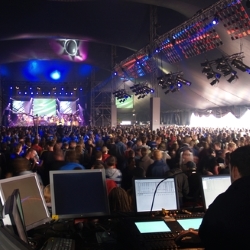
Delayed Zonal Coverage
The solution to the twin problems of an excessive SPL in the near-field, and an uncontrollably reverberant acoustic, lies in the proper use of delayed zonal coverage (1) of the listening area. This, coupled with a reduction in the size and amplitude level of the main loudspeaker arrays.
We have seen, however, that it is not always possible to fly the sound system, and a reduction in amplitude sufficient to render a stacked loudspeaker array listenable from a couple of feet away, will render it useless at 50ft(15.2m). I’m not going to advocate delayed zones every 40ft(12.2m)!
The Answer Is Simple
We must be able to fly our ‘reduced’ system, or, at the very least, have the means available to stack these systems above the level of the audience seating; if necessary in purpose built PA towers. Unless we elevate the main loudspeaker array the use of delayed arrays will only solve part of the problem.
I can already hear the cries of “We never fly in here”; “It’s the regulations”; “We always do it this way”. My personal favorite is “…we had the ‘Simple Sonics’ in here last night and they sounded great, just like the record!” How about…“People are used to sitting there”, or “If they can’t hear they should have bought a better ticket.”
All of these appalling excuses are really saying that we needn’t spend the time and effort or money required to do the job we are capable of. “Don’t you know there’s a recession on?”
Let’s face facts. We live in a litigious society and live shows are too loud from any standpoint, but particularly that of health and safety. The coming wave of lawsuits is as inevitable as rain on a show on Mud Island. Check your liability insurance.
By comparison, the one time cost of reinforcing a roof or installing flying points or other loudspeaker support positions is a pittance: Although let me be clear in saying that these measures represent the barest minimum that can be done.
Let’s also acknowledge the reality that increasing numbers of communities everywhere are restricting sound levels permitted in their venues. If we won’t regulate ourselves then the burghers will, and usually in an arbitrary and ill-conceived way; but who can blame them in the face of a profession’s seeming refusal to even consider the problem.
Building Management
If it seems I’ve been pointing the finger solely at the buildings themselves and therefore at building management, I am not. Indeed many buildings have excellent in-house sound systems installed precisely to address these problems.
Sadly, it would often appear to be the case that these facilities are not properly taken advantage of by the touring productions and their engineers. It is that the building dictates the environment in which we must work.
What is required is an increase in communication and cooperation between the various parties involved in the organization of live shows. That is the building management, the promoters, the artist’s management and touring production staff and the service companies who provide the touring sound systems.
With the paying audience always in mind, management and promoters need to look more closely at the suitability of each building to the show they intend to bring in; not just at venue availability. The production staff, likewise, need to design systems, both lighting and sound, that are better suited to the limitations of all the buildings on a particular tour. (In so doing, they can also minimize the expense of having a truck-load of equipment standing in the street because it won’t fit in the gig.)
Service companies must supply a diversity and flexibility of equipment that will meet the needs of any application. Of course these service companies must respond to the marketplace and if there is no demand there is no supply.
Delay Zones
So far we have been suggesting that flying the sound system and reducing its size and volume, can alleviate the problem of an excessive SPL close to the stage. Now let’s examine delay zones.
The second of our twin problems concerns the apparently uncontrollable reverberant field, especially toward the rear of the room. We posed the question, can the reverberation be controlled? The answer is no and yes!
The strength of the reverberant field relates directly to the power of the direct field. If we reduce the power of direct field, i.e. the volume of the main loudspeaker arrays, we will reduce the strength of the reverberation. The corollary of this is a reduction in the area of coverage provided by the main loudspeaker arrays, without eliminating the reverberant field.
The yes part of the answer lies in the fact that we can use delayed zones of loudspeaker arrays to extend the area of direct field coverage without, appreciably, adding to the strength of reverberation. To understand how to do this we need to look, briefly, at the character of ‘acoustic’ as opposed to ‘electronic’ reverberation.
